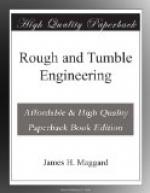If at any time your engine refuses to start with an open throttle, notice your governor stem, and you will find that it has been screwed down as far as it will go. This frequently happens with a new engine, the stem having been screwed down for its protection in transportation.
In traveling through timber with an engine, be very careful not to let any over-hanging limbs come in contact with the governor.
Now I think what I have said regarding this particular governor will enable you to handle any one you may come in contact with, as they are all very much alike in these respects. It is not my intention to take time and space to describe a governor in detail. If you will follow the instructions I have given you the governor will attend to the rest.
Part second ________
WATER SUPPLY
If you want to be a successful engineer it is necessary to know all about the pump. I have no doubt that many who read this book, cannot tell why the old wooden pump (from which he has pumped water ever since he was tall enough to reach the handle) will pump water simply because he works the handle up and down. If you don’t know this I have quite a task on my hands, for you must not attempt to run an engine until you know the principle of the pump. If you do understand the old town pump, I will not have much trouble with you, for while there is no old style wooden pump used on the engine, the same principles are used in the cross head pump. Do not imagine that a cross head pump means something to be dreaded. It is only a simple lift and force pump, driven from the cross head. That is where it gets its name and it don’t mean that you are to get cross at it if it don’t work, for nine times out of ten the fault will be yours. Now I am well aware that all engines do not have cross head pumps and with all respect to the builders of engines who do not use them, I am inclined to think that all standard farm engines ought to have a cross head pump, because it is the most simple and is the most economical, and if properly constructed, is the most reliable.
A cross head pump consists of a pump barrel, a plunger, one vertical check valve and two horizontal check valves, a globe valve and one stop cock, with more or less piping. We will now locate each of these parts and will then note the part that each performs in the process of feeding the boiler.
You will find all, or most pump barrels, located under the cylinder of the engine. It is placed here for several reasons. It is out of the way. It is a convenient place from which to connect it to the cross head by which it is driven. On some engines it is located on the top or at the side of the cylinder and will work equally well. The plunger is connected with the cross head and in direct line with the pump barrel, and plays back and forth in the barrel. The vertical check valve is placed




